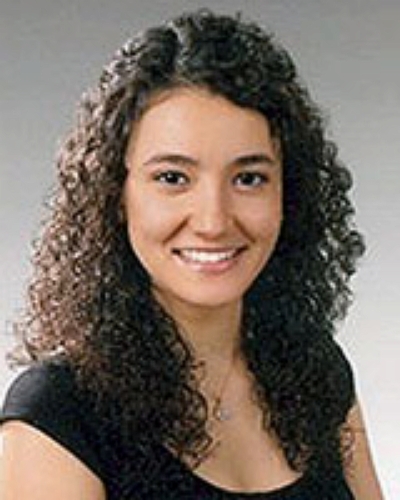Introduction
Coronavirus disease (COVID-19) was declared a pandemic by WHO on 11 March 20201. As of 25 March 2020, schools and educational institutions were temporarily closed in 150 countries, affecting more than 80% of the world’s student population2. To reduce the rate of spread of the pandemic in Turkey, education was suspended for a week in all universities from 16 March, and the distance learning opportunities and capacities of the universities were determined. On 23 March 2020, the distance learning process started in all Turkish universities3.
The pandemic has caused the greatest disturbance in the education system worldwide; the need for new information and communication technologies has increased rapidly and has caused the obligatory transition to alternative education methods such as distance learning4,5. Distance learning is an education method that does not involve traditional face-to-face interactions between instructors and students. Because there is no need to be geographically co-located, instructors and students can physically be in different locations, but they can still teach and learn as if they were together in the same classroom6. Information and communication technologies such as message boards, discussion forums, video conferencing and the institutional distance learning applications are actively used to facilitate the student learning process7.
Pamukkale University’s institutional distance learning application (Live Lesson System) started to be used actively in all academic units during the pandemic. The application has many features. Course materials (such as presentations and video recordings) can be uploaded by the academician before the course and students offered the opportunity to download. Interactive lessons can be conducted with the direct participation of students and academicians, and all course videos can be recorded for students who cannot attend the lessons. All students can re-watch and download the recorded course. Mid-term and final exams can also be held online in multiple-choice and/or open-ended format or homework (research, performance, or project paper) format. Student–faculty interaction can be established via the application (online, email exchange). In addition, technical support is provided to academicians and students with Live Lesson System application issues. Although the university had basic infrastructures and effective corporate strategies to deliver high-quality teaching, students’ attitudes towards and perceptions of distance learning, which was a new and unfamiliar method for them, were unknown.
The Bachelor of Physiotherapy and Rehabilitation in Turkey is a 4-year program that mostly includes practical courses and clinical practice. The program includes theoretical and practical courses, seminars, and summer field internships in the first 3 years, and hospital clinical rotations in the last year. In this context, there are more practical lessons and clinical practice applications every year. Although distance learning had not been experienced in physical therapy and rehabilitation education in Turkey before the COVID-19 pandemic, its use became obligatory to ensure educational continuity through the outbreak. Issues related to the integration of practical courses and clinical training into distance learning in a very short time, and technical and infrastructural deficiencies, can interfere with student learning. Students who are more familiar with face-to-face learning environments may feel isolated, and be less satisfied with distance learning, and this can affect their acceptance and attitude towards this new form of education. Therefore, educators should analyse the effects of existing changes on students to determine new educational principles and practices8. Therefore, the purpose of this study was to (a) determine the acceptance and attitudes of Pamukkale University Physical Therapy and Rehabilitation undergraduate students towards distance learning during the COVID-19 outbreak and (b) compare the results among years.
Methods
Participants
This study was conducted from May 2020 to June 2020 at the Pamukkale University School of Physical Therapy and Rehabilitation, Turkey, which had an enrolment of 620 undergraduate students. Students receive a bachelor’s degree after completing the four academic years (eight-semester program) offered by the School of Physical Therapy and Rehabilitation. Study information and online survey links were sent to all students via their WhatsApp groups, and volunteers who gave their informed consent in the online questionnaire were included.
The sample of this study consisted of all students in the spring term of their first, second, third, or last year. All 620 undergraduate students were invited to take part in the study; 71 (from 143) first-year students, 90 (from 130) second-year students, 125 (from 140) third-year students from and 95 (from 207) fourth-year students agreed to participate (Fig1).
Outcome assessment
Demographic data (age, gender, and academic year) of the students were recorded.
Students’ attitudes towards distance learning were evaluated using a scale developed by Kurt and Özkan9 to measure the distance learning process of Istanbul University. The original questionnaire consists of 48 items, including questions about demographic information and attitudes towards the distance learning system, and open-ended questions. Sixteen items that were deemed appropriate for the distance learning implemented at Pamukkale University were selected from this survey. The questionnaire classified four subdimensions: proficiency of the academician, course content, Live Lesson System, and quality of service. Answer options were categorized according to a 5-point Likert scale (strongly agree, agree, neither agree nor disagree, disagree, and strongly disagree) and the results are presented as numbers and percentages.
Distance Learning Systems Acceptance Scale: The Distance Learning Systems Acceptance Scale aims to evaluate student satisfaction with distance learning in terms of perceived ease of use and perceived utility dimensions in the technology acceptance model. The 7-point Likert-type scale consists of two subdimensions: ease of use (two items, score range 2–14) and benefit (four items, score range 4–28). The Turkish validity and reliability study of the scale was conducted10. Total scores ranged from 6 to 42 points, with higher scores indicating higher technological acceptance.
Community Feeling Scale: The Community Feeling Scale is used to determine the sense of community of students studying online in distance learning. The 7-point Likert-type scale has two subdimensions: affective dimension (four items, score range 4–28) and operational dimension (two items, score range 2–14). The Turkish validity and reliability study of the scale was conducted11. Total scores ranged from 6 to 42 points, with higher scores indicating a strong sense of community.
Distance Learning Attitude Scale: The Distance Learning Attitude Scale is used to determine the attitudes towards distance learning of university students. The scale consists of four subsections: general acceptance (score range 7–35), individual awareness (score range 6–30), perceived usefulness (score range 3–15), and application effectiveness/effective participation (score range 4–20). The Turkish validity and reliability study of the scale was conducted12. Total scores ranged from 20 to 100 points, with higher scores indicating positive attitudes.
Statistical analysis
The obtained data were analysed using the Statistical Package for Social Sciences software v24 (IBM; https://www.ibm.com/products/spss-statistics). In the analysis of the descriptive characteristics of the students, the continuous variable (age) was presented as mean ± standard deviation, and categorical variables (gender, academic year, distance education experience before the pandemic) as absolute number (n) and percentage (%). Attitudes Towards Distance Learning data were expressed as frequency (%), and Distance Learning Systems Acceptance Scale, Community Feeling Scale, and Distance Learning Attitude Scale scores were expressed as mean ± standard deviation (minimum–maximum). In comparison analysis between years, normality of data distribution was assessed by the Kolmogorov–Smirnov test. Datasets were not conforming to the normal distribution. The Kruskal–Wallis test was used for comparisons of median values among years, followed by post-hoc testing using un-paired Mann–Whitney U-tests. Statistical significance was defined at the 5% (p≤0.05) level.
Ethics approval
Study permission was obtained from the Republic of Turkey Ministry of Health and approved by the Pamukkale University Non-invasive Clinical Research Ethics Committee (approval no. 34153).
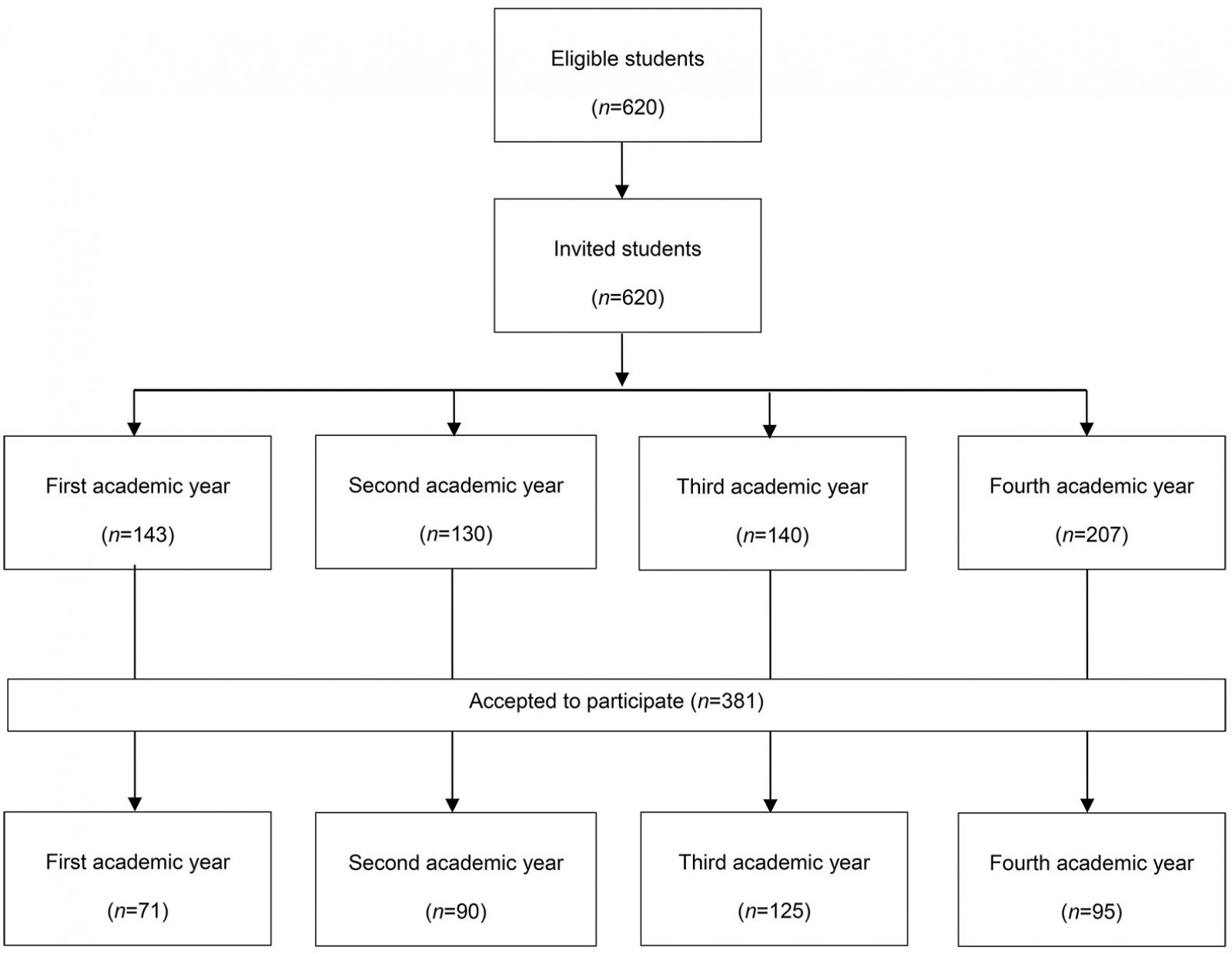 Figure 1: Flowchart of the study.
Figure 1: Flowchart of the study.
Results
A total of 381 students (71 first year, 90 second year, 125 third year, and 95 fourth year) voluntarily participated in the study. Of these, 271 (71.1%) were female and 110 (28.9%) were male. The mean age was 21.91±2.48 years (range 18–35 years). Descriptive characteristics of the students are provided in Table 1.
Table 2 presents data on the proficiency of the academician, course content, Distance Learning System, and quality of service. Although most students rated the proficiency of the academician as high in distance learning courses, 36.5% said that the academician focused on the whole course content rather than spending more time on sections that were harder to understand. According to 49.4% of students, course content was sufficient for understanding the section, but for 39.4%, course notes were as important as videos for a successful grasp of the information. According to more than half of the students, the Live Lesson System application was understandable (71.9%), simple and useful (71.7%), and had a positive effect on student success (62.5%). The quality of the Technical Support and Student Counseling Unit was sufficient for most students.
Distance learning attitudes of students are shown in Table 3. According to the Distance Learning Systems Acceptance Scale, students’ technology acceptance was moderate (mean 22.89±9.21). Students were unsure about the ease of use (mean 8.91±3.56) and benefits (mean 13.98±6.99) of the distance learning system. The sense of community among students was moderate in the distance learning environment (mean 20.39±8.93). Students reported partly positive attitudes towards distance learning (mean 54.10±17.60), but were undecided about individual awareness (mean 14.83±6.58), usability (mean 8.79±3.47), and effective participation (mean 11.63±3.67).
Table 4 provides a comparison of attitudes towards distance learning among academic years. Distance learning system acceptance, sense of community, and distance learning attitude levels were highest in fourth-year students, followed by first-, third-, and then second-year students. The distance learning and community sense scores of first- and fourth-year students were significantly higher than those of second- and third-year students (p≤0.01).
Table 1: Descriptive characteristics of students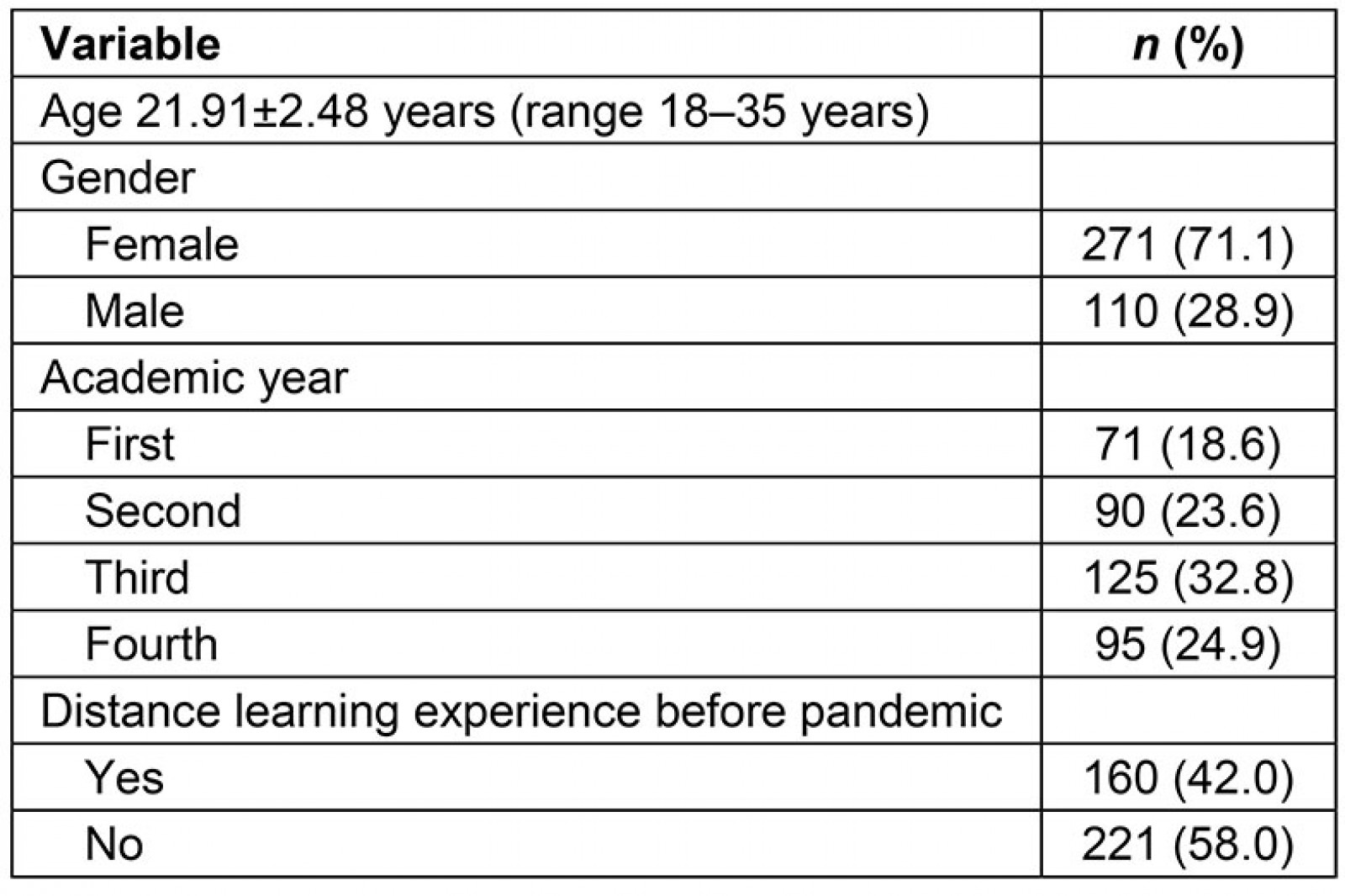
Table 2: Attitudes Towards Distance Learning
Table 3: Student acceptance and attitudes towards distance learning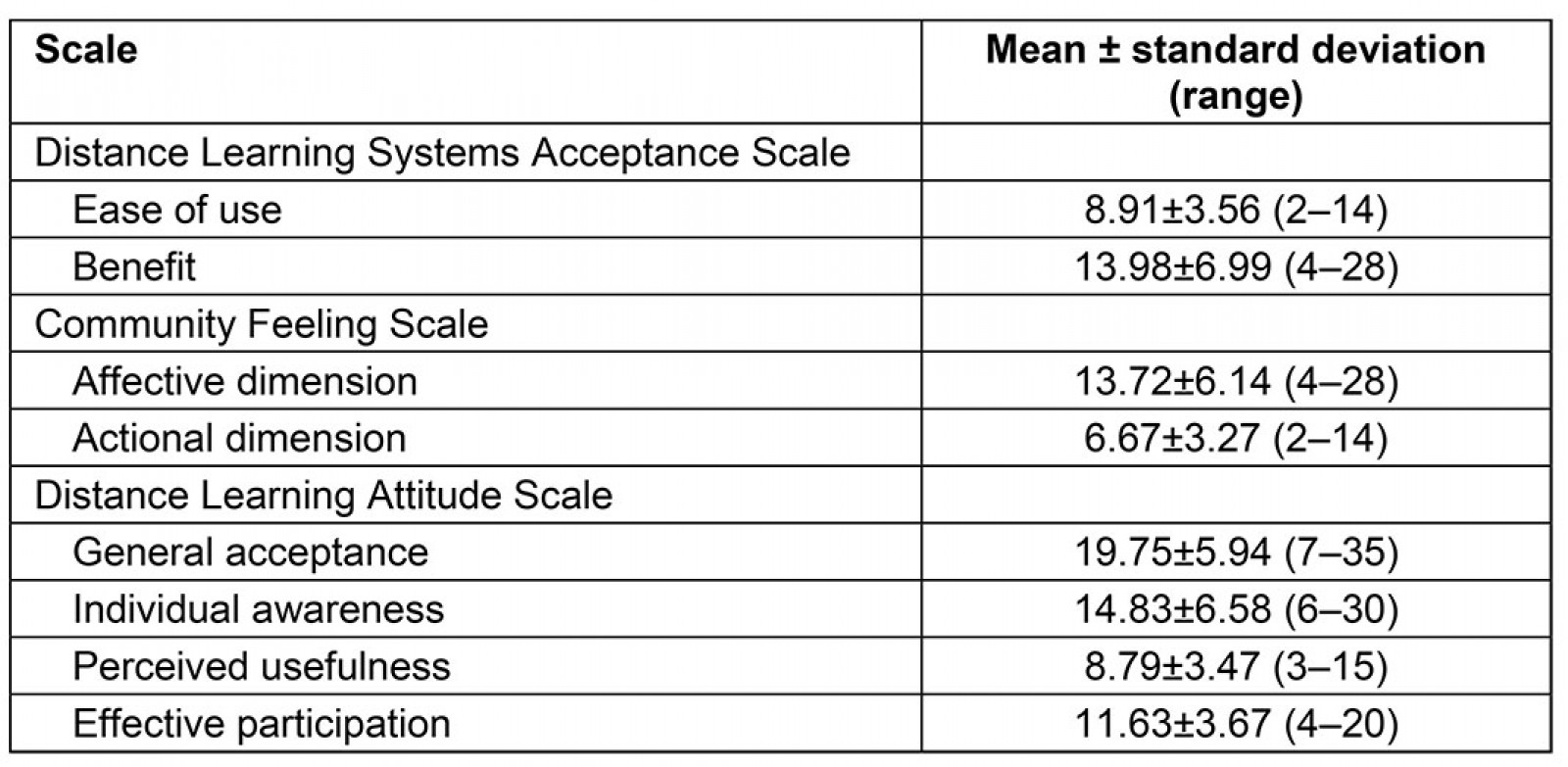
Table 4: Comparison among years of acceptance and attitudes towards distance learning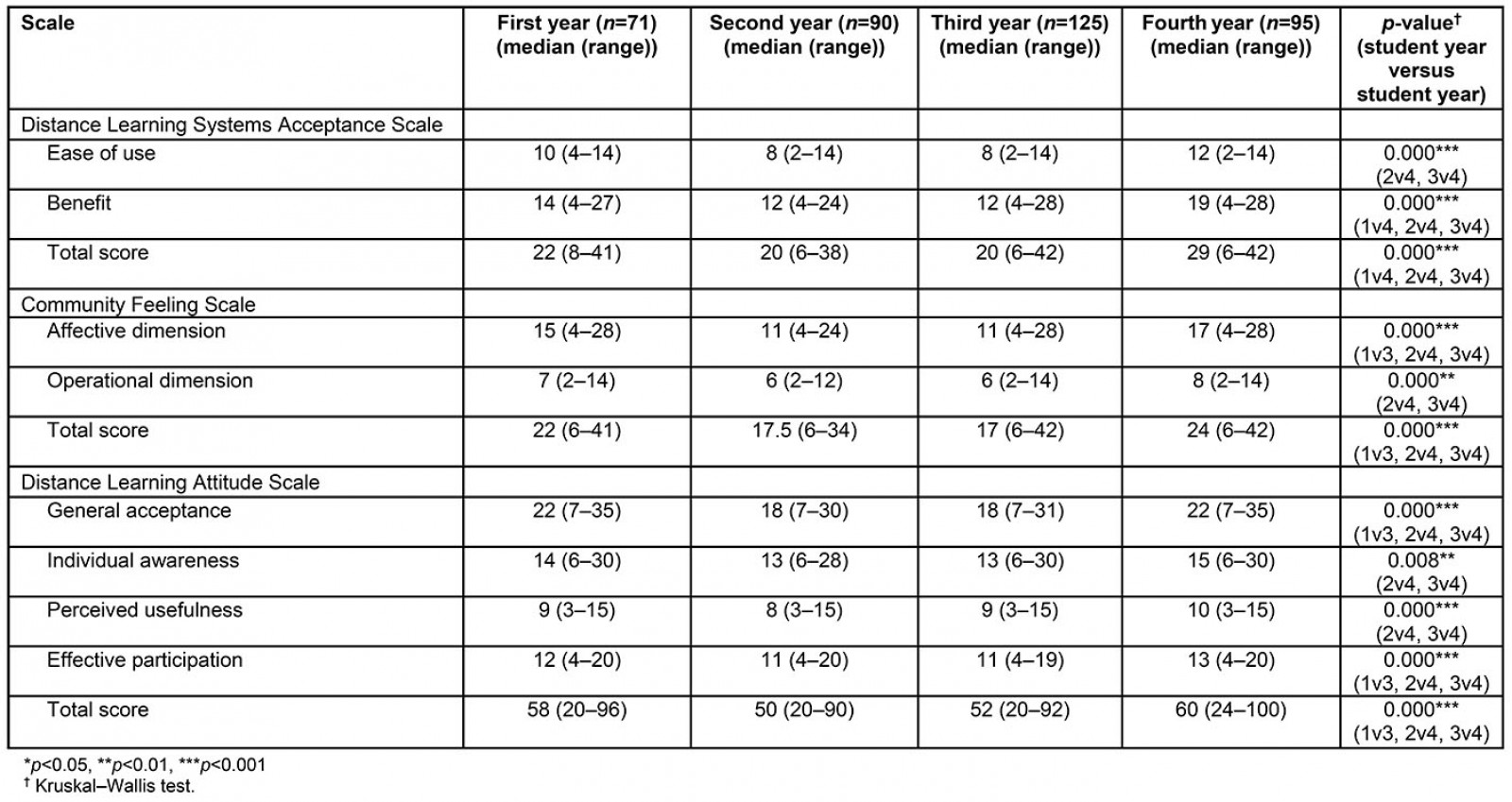
Discussion
For many teaching staff and students, the COVID-19 pandemic has meant teaching and learning via the distance learning model for the first time. In this study, despite issues such as being unprepared and the need for technical infrastructure improvements, distance learning showed promise as an effective means for meeting the needs and potentially enhancing the skills and knowledge of physiotherapy and rehabilitation students. For most students, the proficiency of the academician was reported as high in distance learning and the course content was sufficient. For successful learning, written materials (course notes) were as important as visual materials (distance learning videos). Moreover, the application of the Live Lesson System was understandable, simple, and useful for more than half of the students, and the quality of the Technical Support and Student Counseling Unit was sufficient; all of these can have a positive effect on student achievement. Although students were unsure about ease of use/usability and benefits (eg learning performance, productivity, lesson following, using time efficiently, participation) of distance learning systems, they had partly positive attitudes towards distance learning. Students’ attitudes towards distance learning, acceptance, and sense of community were highest in the fourth year.
The claim that distance learning is a highly appropriate training method for the modern global society requires student acceptance and satisfaction of distance learning, and effective interaction of the parties (student, academician, administrator). In addition, online systems that are easy to use and regularly updated should be available13,14. Attitudes of students in distance learning programs are generally positive13,15, but the students who began their Physical Therapy and Rehabilitation education in face-to-face classes and had to shift to the distance learning program were uncertain. Although online technologies (ie websites and discussion boards) have many benefits for physiotherapy teaching and learning (to improve practical skill performance and knowledge acquisition, provide students with entertaining, easily accessible resources, enhance deep learning, and encourage reflection)16, to the authors’ knowledge no physiotherapy undergraduate program in Turkey, or elsewhere in the world, is completely carried out with distance learning. In this study, the attitudes of Physical Therapy and Rehabilitation undergraduate students towards distance learning during the COVID-19 pandemic were positive. High academic quality and timely software updates to solve glitches may have contributed to students’ positive attitudes towards distance learning. Attitudes towards distance learning were higher in first- and fourth-year students than in others. This may be because there are more theoretical courses than applied courses in the first academic year. Also, fourth-year students had taken almost all of the course and had completed their first-semester internships and nearly half of their second-semester internships before the shift to distance learning. Most of the second and third academic year curricula consists of practical courses and summer field internships. In face-to-face education, students practise on mannequins and their peers in the clinical skills laboratory. However, the video demonstrations of clinical practices in distance learning may have affected their attitudes towards distance education.
Effective learning takes place in an environment with a strong sense of community that includes social and cognitive dimensions17. With the increasing social presence of students studying online, students will feel that they are part of this learning environment, and their satisfaction should increase18. Students who experience the distance learning environment after face-to-face education may not be able to achieve the maximum benefits of distance learning. They may feel isolated, lonely, and separate, and therefore may avoid distance learning. To improve the quality of distance learning, students need to have a sense of community and to interact and participate in the course as they do in traditional classroom education19. Although a sense of community decreases significantly in students physically located in separate places20, in recent years it has been suggested that the sense of community can be enhanced by shaping communication and interaction in a student-centered way and by encouraging more student participation13. In this study, the sense of community among students was moderate in the distance learning environment. The rationale for this moderate sense of community is that the students are not obliged to attend live lessons, because they can watch the video recordings at any time. Although there were opportunities to take part in a course via audio and video connections, students were not enthusiastic about doing so. The authors think that a sense of community could be increased by encouraging each student to participate in the course in real time. In addition, the academician’s skill in conducting the course interactively and giving more responsibilities to students could also contribute to the sense of community.
Turkey ranks last among European countries in terms of number of physiotherapists per capita21. Because of the shortage of physiotherapists in Turkey, it is important that these students continue their education without interruption so that more students can enter the profession. Education could continue with distance learning during the pandemic period, and students, in particular at the graduation stage, were able to start their profession by completing their bachelor degree without interruption. Although there have been promising developments in recent years, there are inequalities in the geographical distribution of the human health workforce in Turkey22. Access to physiotherapy services in remote and rural areas can still be considered limited because of increased service demands, limited numbers of physiotherapists, and the availability of services generally in metropolitan areas. In addition, physiotherapists in rural and remote areas may face challenges to participation in postgraduate professional development and training and career development opportunities because most of these opportunities are offered in metropolitan areas and include traditional face-to-face training. These experiences gained in undergraduate education could also be useful in the creation of postgraduate training models and could make knowledge more accessible and sustainable for physiotherapists in remote and rural areas.
Conclusion
Providing students with online communication, continuing education, encouragement, and support can help them get through the challenging COVID-19 pandemic restrictions with minimal impact. However, the pandemic has forced academics to make radical changes in a short time. Although updating course materials and making them available for distance learning is seen as a benefit in this process, the output of this education model should be evaluated very carefully in later ongoing studies.
Despite some problems regarding the management of the process, the acceptance and attitude of physical therapy and rehabilitation undergraduate students towards distance education was mostly positive. This process has presented the necessity for being prepared physically and mentally for such situations. For this reason, after technological infrastructure is established, it is recommended that academicians in all departments of physical therapy and rehabilitation create an education model that includes written texts, online clinical skills videos, video or illustrated case examples, online exams, and clinical skills evaluation methods. In addition, discussion forums and online course participation should be encouraged to ensure high student involvement.
